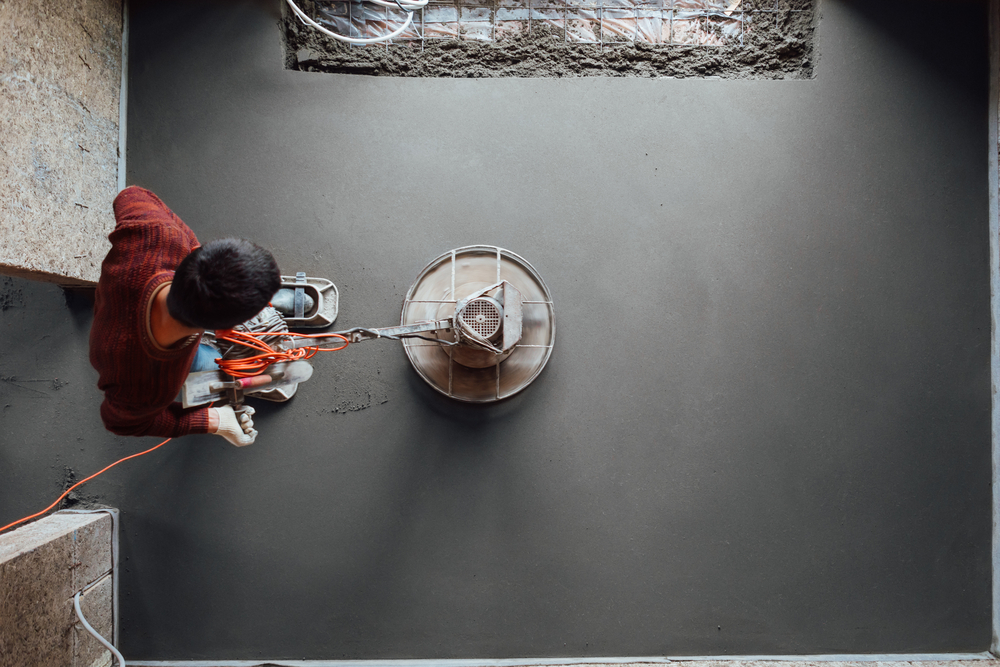Concrete is not a standardized product, and this is the first thing you need to grasp! Each project will provide its own unique set of circumstances and problems, some of which may need you to deviate from your standard operating procedures.
It is possible to polish almost any concrete floor that is structurally solid, regardless of how old or new the floor is. However, there are certain exceptions to this rule. For instance, when polishing brand-new floors, you don’t need a unique mix design to get good results. However, the floor should be installed for at least 28 days before the polishing process begins to guarantee that it has adequate time to cure.
Some retail and warehousing establishments that intend to polish their floors after placement may specify a floor that is as smooth as possible in order to cut down on the number of polishing steps that are necessary.
In order to remove dirt, oil, coatings, or flaws from existing floors, some surface preparation is often required before polishing can take place. It is important to keep in mind, however, that floors that are wavy, in need of substantial patching, or excessively porous may not be excellent candidates for polishing.
If the concrete is not up to the task at hand, then the finish will never attain the desired aesthetics or usefulness. Because of this, getting the substrate prepared properly is an essential component of every polished concrete project. For the new coating to properly adhere, the concrete must first be cleaned, leveled, and given a light texture. This is especially important if the concrete is old or has been subjected to a significant amount of use.
Grinding is typically the most effective method for accomplishing this goal. You might be wondering why grinding is the most effective way to prepare a surface. Grinding allows you to remove old floor coverings such as epoxy, paint, carpet adhesive, and self-leveling compounds, while simultaneously leveling out the underlying concrete surface and creating the ideal surface for further treatment of your floor. This is all accomplished in one operation thanks to grinding’s multitasking capabilities.
It is preferable to keep the substrate intact during any refurbishing project, if at all possible, rather than tearing it out along with the old floor coating and starting again. If you do this, you can avoid the need to apply a self-leveling compound and the need to pay needless material costs in the form of additional covers to fill up imperfections, both of which are time-consuming and expensive.
If you are unsure about the best way to proceed, it is recommended that you speak with the technical representative of the supplier of your equipment and materials to receive ideas on how to move forward. If the concrete is of a high enough quality and it is correctly prepared prior to work on the finish, then there should be no reason why it is impossible to make a high-end polished concrete floor. This is the answer to the question posed in the title.
Concrete that has been honed has a finish that is comparable to that of mechanically polished concrete (MPC), which is used indoors. However, the honed finish is not nearly as refined as the MPC finish. The Honed finish is achieved by grinding to a grit of either 60 or 120; this is the optimal level because it makes the surface slip-resistant. It has had a penetrating sealer applied to it in order to protect the concrete, and this sealer can either be invisible, in which case there will be no change to the color of the concrete, or color enhanced, in which case the concrete will be enhanced and made darker. On the other hand, mechanically polished concrete is the result of a more involved procedure that entails first densifying and hardening the concrete, followed by the application of resins to polish it up to the point where it shines. You have the option of stopping this procedure at a matte finish, continuing to polish it up to a semi-gloss or high gloss, or stopping at any point in between.
In general, it is not any more dangerous than other hard flooring surfaces in terms of slipping and falling. If you add water to it, though, it will become slippery just as any other hard surface would. Because of this, we advise going with either the Honed finish (only available in matte) or the Grind and Seal finish for usage in outdoor settings (matte or gloss). The Honed finish naturally resists slipping, and the Grind & Seal finish can have an anti-slip compound mixed in with the sealer to make it slip-resistant as well. We are able to personalize the anti-slip treatment to meet your specifications, which means that we can add as much or as little of the substance as necessary to achieve the desired outcome.
Mechanically polished concrete is slip-resistant in most situations, but, like many other flooring types, it becomes dangerously slippery when wet. We suggest the Grind and Seal process for polished concrete or an alternative coating such as epoxy if you need a non-slip floor. These flooring choices allow us to add a grit to the top layer, creating a non-slip surface. These are perfect for use in damp settings, such as around pools or in the great outdoors.
The ideal characteristics of industrial flooring are resistant to chemical and slip damage. Because of this, we typically advise either an epoxy coating or polished concrete floors; The Concrete-Etc is an industry leader in both, and a member of their helpful team can fill you in on all the details.
The answer is yes, but a non-slip mat should be placed in the wet area if you opt for a Hiperfloor or perform a grind and seal with an anti-slip compound. By grinding and sealing the concrete, a watertight topical sealant is created.


